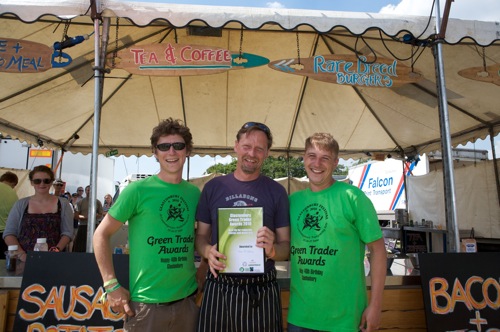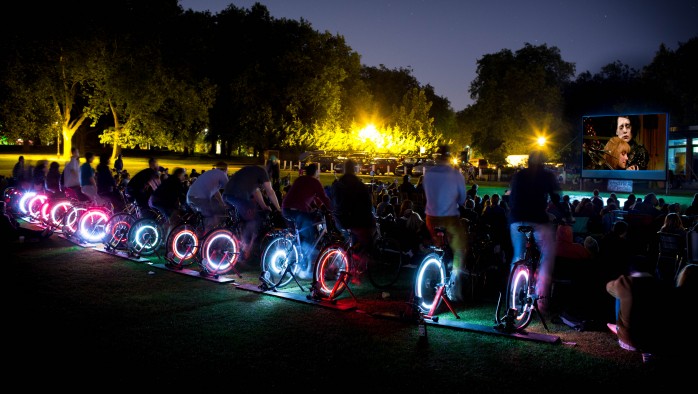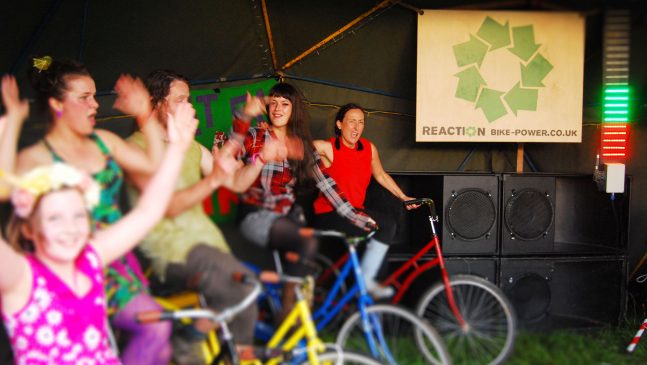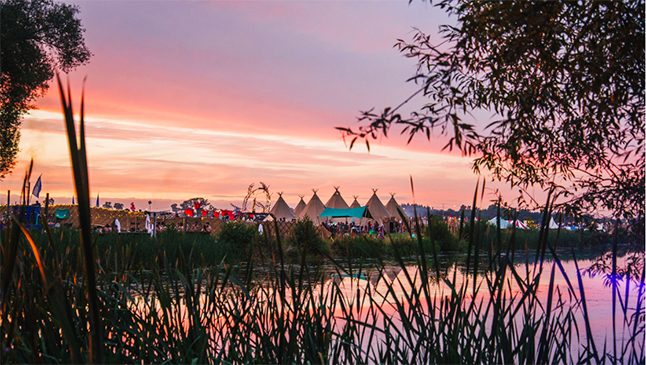Bike-powered: interactive and innovative energy provider
Reaction Sound System (RSS) use audience participation to power small to medium-sized stages with specially designed bike generators. The audience can see how much power the pedalled bikes have created through responsive meters that show how much energy is available in the storage system.
RSS was developed as part of an on-going project to create a small and efficient sound system that is louder for less energy, can travel lightly and that can harness the muscle-power and enthusiasm of the audience to power the show. What began as a curio act at festivals is now a reliable and sustainable sound system that engages the audience with event sustainability by involving them in the practicalities of powering a stage.
RSS now appears at 8 or more large events each year, including the main reggae stage at Eden Festival, a live & DJ stage at Alchemy, the Cocoon stage at Shambala and at many other smaller festivals and events.
RSS began in the summer of 2009 when they trialled 3 bikes, two ‘tyre and roller’ systems and one ‘belt drive’ system to create power for their sound system. They found the belt drive system to be more efficient and with the help of funding in 2010 they built 5 more bikes, each with generators rated at up to 300 watts. RSS invested in finding the most efficient speaker system and custom-built US designed line array, horn loaded speakers (designed to make sound hold its proportion over distances). These efficiency measures meant that the energy from 6 cyclists could provide quality sound for audiences of up to 2000, in tents as long as 60 meters. With 3 adults pedalling hard the speakers can provide enough good quality sound to cater for around 200 people.
Sound systems are customarily measured in power, under the assumption that a larger energy capacity equates to a louder rig. However this assumes all rigs run at equal efficiency and doesn’t take Sound Pressure Level (SPL) or quality into account. This makes the RSS hard to compare to normal battery or diesel-generator powered rigs but, to put it’s efficiency in context, a standard small PA sound system needs 16 watts to match the output RSS can achieve from just 1watt! Although not required, a second stream of power can come from backup batteries, putting an extra 300 watts in to help the cyclists which is useful for engineers during during the headline performances or brief lulls and sound checks.
If everyone gets off the bikes at once it takes around 3 minutes for the 20 segment LED power meter to go from full to empty. RSS occasionally let the charge level drop so that the music stops completely in order to demonstrate the audiences’ vital role in the show. From empty, it takes about 1 minute of cycling to get the system operational again and they often use audio samples from well-known performers and a compère to encourage people on the bikes.
RSS are on a mission to evolve sustainably. They have built two new bikes for the summer of 2016 meaning they now have 8 bikes and additional capacity for energy and volume. They have also added a compact modern solar-powered Lithium-Ion battery bank, which they will use to power stage lights, processors and DJ kit, so that more of the pedal power is directly available for powering the speakers.
Many thanks to Reaction Sound System for providing the information for this case study.
Website: http://bike-power.co.uk/




